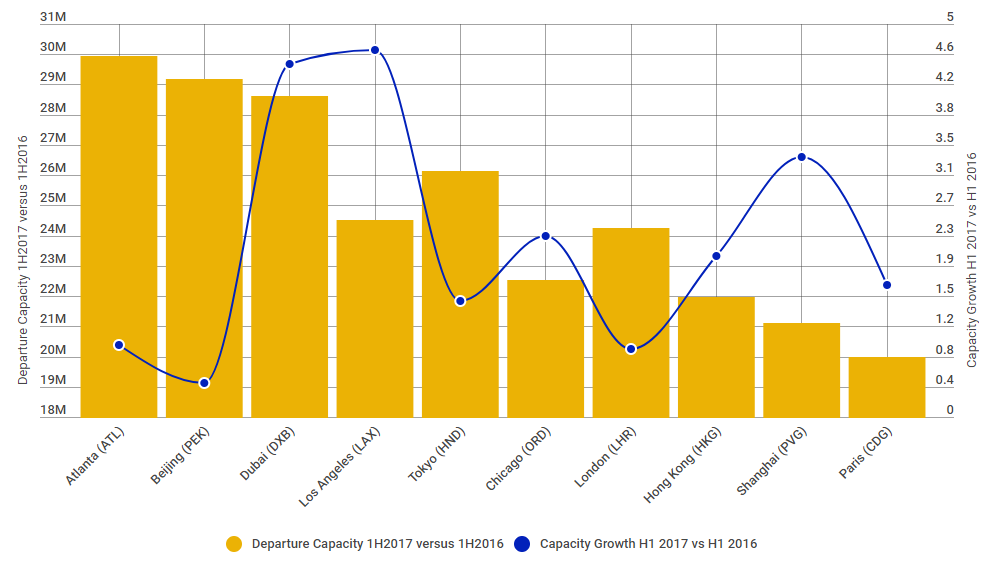During the first six months, the top country destinations in terms of total passenger volumes were India (5,943,359), Saudi Arabia (3,108,492), the UK (3,064,172), Pakistan (2,207,497) and the US (1,561,559). In terms of percentage growth, top regions during the first half were South America (36.4%), Eastern Europe (28.7%) and Asia (18.7%). Top cities by passenger volumes include London (1,893,038 passengers), Mumbai (1,205,504), Bangkok (1,037,606) and New Delhi (1,016,183).
CHART - Dubai International had the second fastest growth in terms of departure capacity among world's ten largest airports in H1 2017 Source: The Blue Swan Daily and OAG
Source: The Blue Swan Daily and OAG
The first month of the second half of the year has already shown a return to higher growth rates with DXB recording its busiest month ever with a 5.9% year-over-year rise for the month as traffic levels grew from 7,616,792 passengers in July 2017 to 8,065,789 in July 2017.
South America was the fastest growing region in July with traffic surging 59%, followed by Asia at 20% - with China and Thailand as top contributors to traffic from the region, Eastern Europe at 16.3% and Africa which grew by 9.1%. India retained its position as the top destination country, followed by the UK and Saudi Arabia.
"We are pleased with the growth in the first half. We will continue to focus on improving service quality at DXB by bringing in new experiences and services to engage and delight our customers," says Paul Griffiths, chief executive officer of Dubai Airports. He showcases some of the new developments that are transforming the airport experience.
It is a similar growth story at Dubai World Central Al Maktoum (DWC), Dubai's second airport, where traffic grew by more than a third in the first half of the year. DWC welcomed 554,993 passengers in the first half of 2017 compared to 410,278 passengers during the first six months last year, a growth of 35.3%. The first half numbers were boosted by consistent growth in the second quarter when passenger traffic rose 45.1%.
Flight movements during the period actually declined -11.1% versus the corresponding period in 2016, boosting average passengers per flight by more than a third, up 34.4% from 90 in the first half of 2016 to 121 for the first half of this year. The top regions for DWC in terms of passenger volumes during the first half were Eastern Europe (207,798 passengers), the GCC (170,424), Western Europe (61,459) and the Indian subcontinent (55,785 passengers).
The increased traffic volumes have been driven by both scheduled and chartered carriers with Mr Griffiths highlighting the "easy availability of slots to quick turn-around times, access to new catchment area, and quick transit times for passengers," for the increased popularity of the airport has an alternative to Dubai International.
CHART - While widebodies dominate at Dubai International, flights out of Dubai World Central this week is limited to short-haul equipment from LCCs Source: CAPA - Centre for Aviation and OAG
Source: CAPA - Centre for Aviation and OAG
DWC is currently served by eight passenger carriers, operating an average of 95 flights weekly to 14 international destinations and is home to 26 scheduled cargo operators (Freight volumes were up a more modest 3.2% in the first half of 2017) that fly to as many as 70 destinations around the world. The airport is undergoing a major expansion that will see its annual capacity increase from the existing 5 million passengers to 26 million passengers.